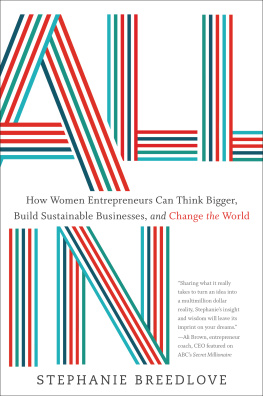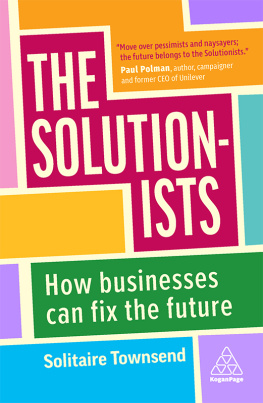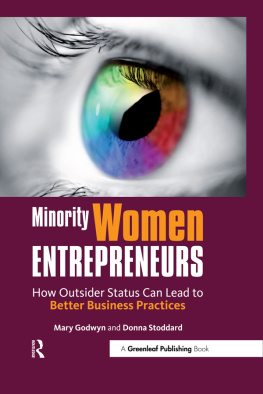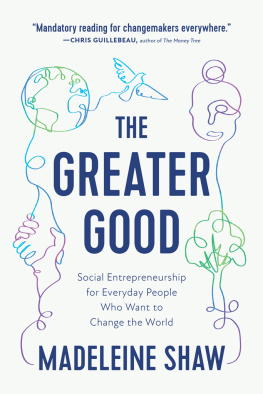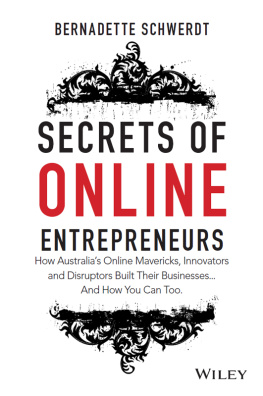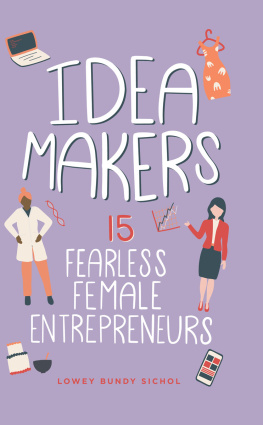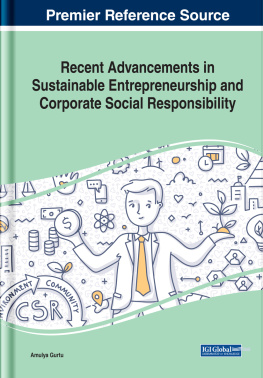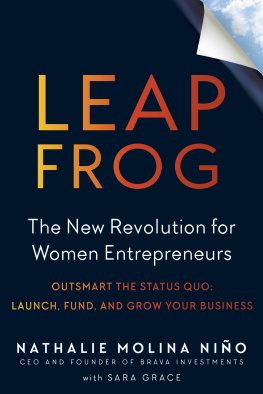
This publication is designed to provide accurate and authoritative information in regard to the subject matter covered. It is sold with the understanding that the publisher and author are not engaged in rendering professional services. If legal advice or other expert assistance is required, the services of a competent professional should be sought.
Published by Greenleaf Book Group Press
Austin,Texas
www.gbgpress.com
Copyright 2017 Breedlove Ventures, LLC
All rights reserved.
No part of this book may be reproduced, stored in a retrieval system, or transmitted by any means, electronic, mechanical, photocopying, recording, or otherwise, without written permission from the copyright holder.
Distributed by Greenleaf Book Group
For ordering information or special discounts for bulk purchases, please contact Greenleaf Book Group at PO Box 91869, Austin, TX 78709, 512.891.6100.
Design and composition by Greenleaf Book Group
Cover design by Greenleaf Book Group
Cataloging-in-Publication data is available.
Print ISBN: 978-1-62634-359-7
eBook ISBN: 978-1-62634-360-3
Part of the Tree Neutralprogram, which offsets the number of trees consumed in the production and printing of this book by taking proactive steps, such as planting trees in direct proportion to the number of trees used: www.treeneutral.com

Printed in the United States of America on acid-free paper
16 17 18 19 20 21 10 9 8 7 6 5 4 3 2 1
First Edition
To Entrepreneurship
For taking me on a journey beyond my wildest dreams. Your challenges and gifts have been truly difference-making. Id travel your path one hundred times over.
Never allow a person to tell you no who doesnt have the power to say yes.
Eleanor Roosevelt
Contents
Foreword
Never doubt that a small group of thoughtful, committed citizens can change the world; indeed, its the only thing that ever has.
Margaret Mead
When Stephanie asked me to write the foreword for All In: How Women Entrepreneurs Can Think Bigger, Build Sustainable Businesses, and Change the World, I nearly declined without even skimming the manuscript. Like most of us, I was already overcommitted. I was working too much and had a lot of business travel on the horizon. On top of this, I was in the midst of selling one house and buying another. The timing, it seemed, couldnt have been worse.
Im not sure what inspired me to start reading the manuscript, but once I did, I couldnt put it down. Even before I finished the third chapter I emailed Stephanie and said that I would write the foreword. Now that Ive read the whole book, Im so glad I said yes. As it turns out, the timing couldnt have been better.
Like Stephanie, I started my company, a social venture built on a business model that relied on earned revenues rather than donations or grants, in my twentiesbut I wasnt all in. I started it the same summer I started my PhD in economics... not something I would recommend! I spent all my spare time building the venturethroughout the first several years of my doctorate program, while researching and writing my dissertation, and finally alongside my first job out of graduate school at the Federal Reserve Board under the direction of Alan Greenspan.
I was working full time in Washington, DC, teaching a masters class in economic development at George Washington University, and running my venture, which was by then operating in six countries throughout Latin America and Africa. After accepting a new job in San Francisco, my husband at the time suggested that I take the next steps in my own professional career by focusing my efforts on scaling my social venture (and perhaps attempting to get a little more sleep as well). So I quit my job, moved west, and began the next chapter of my journey. In this book, Stephanie emphasizes how valuable an encouraging life partner can be in these early stages of entrepreneurship, and I couldnt agree more. Im quite sure that I never would have taken the leap without a supportive spouse who had a secure paycheck and health insurance.
However, something still held me back from pouring my heart and soul into this effort. In fact, I was so sure that I wasnt the right one to bring it to scalebecause I didnt have the skill set to do itthat my focus became getting the venture financially stable and in a position to hire someone else to scale it. Im not sure where that lack of confidence came from. I bootstrapped like the best of them. I didnt pay myself until Year 7 or 8, only after Id quit my job, and even then it was only about a quarter of what I was making at my first job (with zero benefits). I was frugal to a fault. I relied on volunteers and interns and hired much more slowly than I should have. A couple years after moving west, the venture had a cushion of $200,000. I opened an office in San Francisco and expanded operations to support three additional countries. At that point, I started looking for the right person to successfully scale the venture.
To make a long story short, the person I hired and the subsequent leadership ran six-figure deficits in their attempt to scale the venture and very nearly ran it out of business. Im happy to say that the board stepped in and turned it around. Now under new leadership, the venturewhich just celebrated its twentieth anniversarycurrently operates in ten locations in seven countries and has exciting opportunities on the horizon. The number of people weve supported through the organization over the last two decades and the impact weve had is one of the things Im most proud of in my life.
Could I have done a better job scaling the company? Possibly. Would it be in a better position now if I hadnt stepped down? I will never know since it was not the path I chose. Why do I tell this story? Because, while I dont choose to waste time regretting decisions I made in the past, I do know that I want to be all in on my next entrepreneurial journey, which is happening as I write this. Hence, reading this book now is perfect timing.
However, I cant explain my next venture without first telling you a little bit about the amazing path Ive been on with the Kauffman Foundation, the largest foundation in the world dedicated to entrepreneurship. My work with Kauffman has allowed me to focus my talents on researching entrepreneurship and better understanding the gender and racial gaps we see in both entrepreneurship rates and entrepreneurial outcomes. Because of my dissertation on the role of race, gender, and discrimination on business performance and my subsequent work at the Federal Reserve on small business financing, I was recruited by the Kauffman Foundation to lead their largest data initiative to date: a longitudinal study of firms that began operations in 2004 and were tracked over a period of eight years. Through this study, the Foundation sought to shed light on early firm dynamics, why some firms grow while most do not, and why few experience the high growth like those that dominate the news. One interesting fact we learned is that high-growth companies come from all industries, not just tech. For example, Sara Blakely founded Spanx, an entrepreneurial firm in the shapewear industry, at the age of 27. In 2013, Sara was the first woman to join Bill Gates and Warren Buffetts Giving Pledge by agreeing to donate over half of her wealth to charity. Today, Sara remains the sole owner of Spanx, having bootstrapped the company herself, and it has annual sales of over $700 million.
Next page
